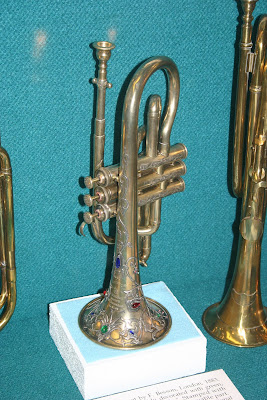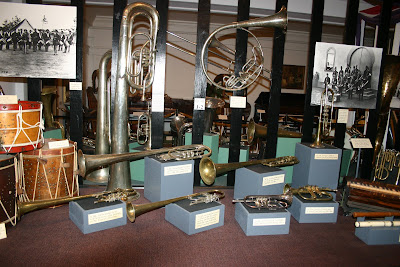On our drive out to the west coast, we stopped in Vermillion, South Dakota to check out the National Music Museum on the University of South Dakota campus.
This place is awesome! Perhaps that is the music geek inside me speaking, but Jason had to drag me away after about 3 hours because I wanted to look at EVERY SINGLE crazy looking instrument, and they have more than 14,500 instruments!
This was in one of the very first display cases, and I was instantly hooked on this place as soon as I saw it! It is a jewel encrusted Besson cornet from 1883!
They have a complimentary headset for each person that Jason is sporting in this picture. It has narration and sound clips of the actual instruments being played!
Having the instrument recordings was most interesting when we got to this instrument. It is called a Choralcelo, and it is played electromagnetically as well as like a traditional piano with hammered strings. It has several "auxiliary attachments" through which the sound can pass to change the timbre.
Here are the auxiliary attachments! It looks like a Rube Goldberg machine. The museum tour said that there were only about 100 of these made, and there aren't very many still in existence because they take up so much room! This one was found in a barn. I think it sounds like a merry-go-round under water.
Another fascinating instrument was this upright piano from 1891 with a unique keyboard invented by Paul von Janko. The keyboard arranges the keys in a much easier way for the human hand. The museum guide said that several world class pianists gave it a try and recognized how much easier it would be, but since they had to basically relearn how to play, it didn't really catch on.
This is called a Glass Armonica, the first mechanical glass harmonica (any instrument played by rubbing glass), designed by Benjamin Franklin. His servant would turn a crank on the side that would rotate the bowls, and then he would use wet fingers to make sounds.
Of course, I was most intrigued by the crazy brass instruments. These are from the Civil War. The bells point behind and over their shoulder so they could be played at the army while the player rides in front on horseback!
These guys are amazing just by being able to play and ride a horse at the same time! Looking through the pictures I took, I have tons of brass instrument pictures, instruments with two bells, extra sound resonators, and things interesting only to us trumpet geeks, so I won't bore you with those. However, I'll leave you with one last picture that you just have to see:
!


































